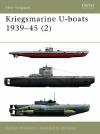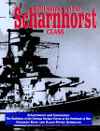U-Boat 977
Schaeffer, Heinz
1975, Tandem Publishing Limited
ISBN 0553267302
9 photos
| Type. | Memoir |
| Pros. | Good account of personal experiences |
| Cons. | Not very useful as a historical reference; also, some controversial elements exist (see below) |
| Rating. |  |
This is a fascinating book for several reasons: it encapsulates the postwar moods of various constituents of Germany; presents Schaeffer's interesting personal experiences in his own words; deals firmly with the myth that Hitler escaped to South America in a U-boat; and, not least, begins with a highly uncomplimentary and ill-willed introduction by Nicholas Monsarrat, author of The Cruel Sea. [Please note that this review refers to the 1952 English edition; other editions may not contain Monsarrat's introduction.]
This introduction, the first text to meet the reader's eyes, is most unpromising. It begins with the words "If U-boat 977 were not two things - a readable book, and an engrossing piece of war history - I would not touch it with a depth charge." It ends, after five pages of anti-German prose, with the statement "Reading [this book], absorbing its filthy and violent outlines, we know just how far politics can travel on the road to insanity, and what men can do to other men in their greedy lust for power." In between, Monsarrat repudiates both war apologists and those who hold that the majority of German people were not Nazis. Statements such as "No one save a power maniac, a sadist, or a nautical romantic can hold any brief for submarine warfare. It is a repellent form of human behavior" are plentiful in this introduction.
Next, Schaeffer explains his reason for writing the book: to lay to rest the persistent rumors, which began when he reached Argentina, that, in company with U-530 in a sort of "ghost convoy", he had carried Hitler, Eva Braun, and Martin Bormann and set them ashore somewhere on the Argentinian coast or at a secret base in Antarctica. These rumors and stories, entirely false, nevertheless pursued him for years.
This book contains some political elements which may render it unappealing to some and certainly make it controversial. But it also provides a rare view of many aspects of naval training and naval life in the 1930s and 1940s. The best parts of the book are those which describe the author's experiences and adventures, particularly his experience of the navy entrance exams (which graded potential entrants on their table manners and employed psychological testing and electric shocks to test their courage) and the harsh training in Dänholm, which included exercises such as running up and down hills in full gear repeatedly for hours on end, and typical basic training abuse from superiors.
After completing basic training, Schaeffer served on the battleship Schlesien as a cadet in the Baltic in 1940. Next he joined his first U-boat as a midshipman, where he was soon shown his lowly station. Here he describes U-boat living conditions, watches, crash dives, and depth charging. He takes the reader on a detailed tour of the boat and examines some of the developing technologies of the war.
While the book rarely includes dates, boat numbers, or commander names, where it is short on this kind of detail it is long on mood. There is a chilling account of a diving accident during training in which the men trapped inside the U-boat, heard to be banging on the hull, were ordered to make an underwater escape. The sound of water filling the boat to equalize pressure was heard, but no one ever came up. After six hours the remaining boats were forced to abandon their vigil and continue their exercise. Later in the war, Schaeffer paints a grim picture of the state of morale at a time when many boats were failing to return, and U-boat men were required to make their wills before setting off on patrol.
Schaeffer describes the rigors of command on U-148 as well as the difficulties of using the Schnorchel on U-977. Then he explains his decision to disobey Dönitz' order to surrender because he was convinced it was an Allied trick. Believing that the Morgenthau plan would be implemented and Germany would be transformed into an agrarian state and its male population sterilized, he embarked on a journey to Argentina with those of the crew who wished to accompany him. Two months after setting off, they surfaced for the first time after 66 days of submerged running.
The last part of the book deals with the constant questioning Schaeffer underwent after surrendering in Argentina by those who were convinced he had transported Hitler and other leaders. The book ends on a rather disturbing note, as Schaeffer attempts to analyze why so many Germans persisted in believing this myth, concluding that many Germans saw Hitler as a kind of King Arthur, a savior who could return to lead them again. Thus, in addition to a compelling autobiography, this book also stands as a record of some of the moods and beliefs that were current in the first few years following the end of the war.
Review written by Tonya Allen.
Published on 13 Aug 2000.
This title is highly recommended.
Return to our main review page.



